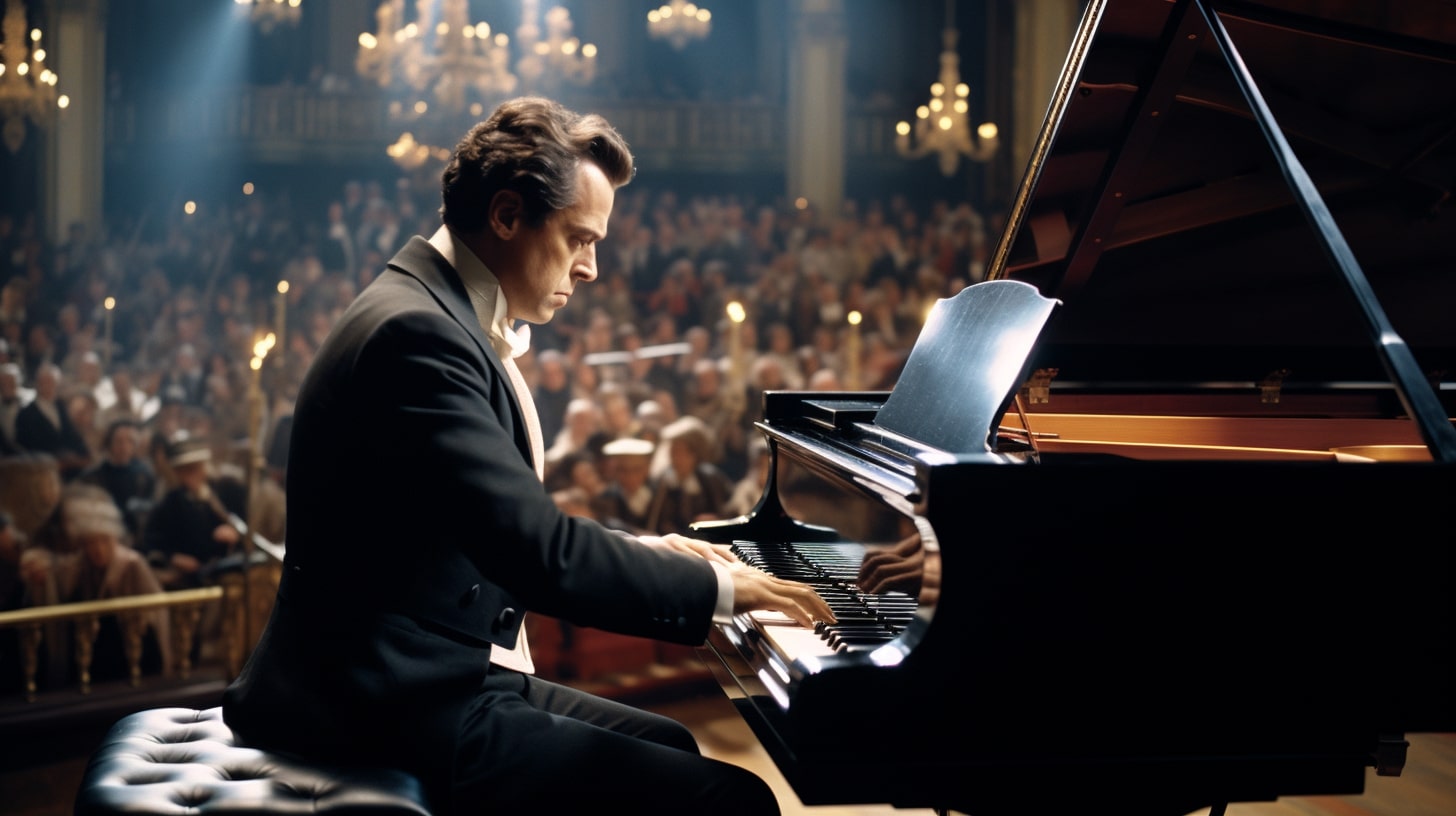Gustav Mahler was one of the leading conductors of his generation and was known for his extensive use of various instruments in his orchestral compositions. Mahler’s works have been celebrated for their unique arrangements and thorough orchestrations that showcase a diverse range of musical instruments.
As a musician, Mahler himself was a pianist and conductor, garnering recognition for both his compositional prowess and his ability to lead orchestras. His vast knowledge of instruments and their capabilities contributed to his distinctive symphonic style, often including unconventional instrument combinations and intricate, multi-layered textures. This has led to Mahler being regarded as one of the prominent composers of his time, pushing the boundaries of orchestral music and leaving a lasting legacy in the classical music world.
Contents
Mahler’s Early Life
Vienna Conservatory
Gustav Mahler, born in 1860 in Bohemia, began his musical education at the prestigious Vienna Conservatory. There, he studied piano, composition, and conducting, honing his skills as a musician. Mahler’s proficiency on the piano grew rapidly, and he was known to be an accomplished pianist in addition to being a composer and conductor.
Influences
Mahler was heavily influenced by the works of great composers before him, such as Beethoven, Wagner, and Arnold Schoenberg. These composers’ works greatly impacted Mahler’s compositions, pushing him to develop his own unique style of orchestral scores and symphonic choruses.
His exposure to various genres of music and his appreciation for diverse styles can be credited to his innovative compositions, which combined various elements to create almost narrative-like symphonies.
Education
In addition to his studies at the Vienna Conservatory, Mahler also attended courses in philosophy and history at the University of Vienna. This broad exposure to different fields of study contributed to the depth of his compositions, often infusing them with rich thematic and emotional content.
Mahler’s early life and education laid the foundation for a prolific career as a composer, which would see him become one of the most significant figures in the late 19th and early 20th-century classical music scene.
Mahler The Performer
Piano and Conducting
Gustav Mahler, known primarily as a composer and conductor, began his musical journey by learning the piano at a young age. His talent for the piano soon paved the way for his interest in orchestral conducting.
Throughout his career, Mahler held prestigious conducting positions in various prominent opera houses and orchestras.
Philharmonic Orchestras
Mahler’s rise in the conducting world took him to numerous acclaimed orchestras. He led the New York Philharmonic and the London Symphony Orchestra during his career.
As a conductor, Mahler was known for his disciplined and meticulous approach, often demanding long rehearsal hours and striving for perfection in each performance.
Operas
In addition to conducting philharmonic orchestras, Mahler also worked in the realm of opera. He held positions at the Leipzig Opera, Prague, and the Vienna Court Opera.
Furthermore, Mahler’s influence reached the United States, where he conducted at the Metropolitan Opera and, later, the New York Metropolitan Opera. Mahler focused on a wide range of repertoires, from classic to contemporary works, showcasing his versatility as a conductor and persevering dedication to the art form.
Mahler’s Compositions
Symphonies and Their Influence
Gustav Mahler was recognized for his contributions to orchestral music in the late 19th and early 20th centuries. He was particularly known for his symphonies, which served as a bridge between the Austro-German tradition and the modernism of the 20th century.
Mahler’s symphonies are characterized by their emotional intensity and intricate orchestrations. Some of Mahler’s most notable symphonies include:
- Symphony No. 1 in D major: Often referred to as the “Titan,” this symphony demonstrates Mahler’s innovative approach to orchestration and thematic development.
- Symphony No. 2 in C minor: Also known as the “Resurrection,” this work is notable for its choral finale, which explores themes of life after death.
- Symphony in F minor: This unfinished symphony showcases Mahler’s early compositional talent and provides insight into his evolving style.
These symphonies and others have had a lasting influence on classical music, with many composers incorporating elements of Mahler’s style in their own work.
Songs and Song Cycles
In addition to his symphonies, Mahler composed various songs and song cycles that showcased his skill as a writer and orchestrator.
His songs often featured introspective and emotional themes, and his song cycles were distinguished by their innovative use of orchestration and narrative structure.
Some of Mahler’s most important songs and song cycles include:
- Das Klagende Lied: This dramatic cantata is based on a fairy tale and was one of Mahler’s earliest works, foreshadowing his later compositional achievements.
- Das Lied von der Erde: Translated as “The Song of the Earth,” this groundbreaking song cycle synthesizes symphonic and vocal music featuring orchestral accompaniment and soloists in a multi-movement work.
- Lieder eines Fahrenden Gesellen: Known in English as “Songs of a Wayfarer,” this song cycle explores themes of love, nature, and solitude and is notable for its innovative use of the orchestra to illustrate the emotional content of the songs.
Throughout his career, Gustav Mahler contributed significantly to symphonic and vocal music, demonstrating his remarkable talent as a composer and his ability to convey complex emotions through his work.
Collaborations and Relationships
Fellow Composers
Gustav Mahler’s influence can be observed in the works of several fellow composers. Notably, Benjamin Britten, an English composer, was deeply inspired by Mahler’s music.
Britten admired the emotional depth and intricate orchestrations in Mahler’s symphonies, which in turn influenced Britten’s own compositions.
Conductors
Many conductors have championed Mahler’s music throughout the years. Among them is Leonard Bernstein, an American conductor, who became particularly well-known for his interpretations and advocacy of Mahler’s symphonies.
Bernstein’s intense passion for Mahler’s music led to a resurgence of interest in Mahler’s works during the 20th century.
Orchestras
Mahler had significant relationships and collaborations with various orchestras. One of his notable positions was as conductor for the New York Philharmonic. While in New York, he also led performances at the prestigious Carnegie Hall, reinforcing his status as a celebrated composer and conductor.
The London Symphony Orchestra and the New York Philharmonic have both performed Mahler’s compositions extensively, guided by the baton of conductor Eugene Ormandy, among others. Ormandy, known for his long-lasting association with the Philadelphia Orchestra, also contributed to the popularization of Mahler’s music in the United States.
To sum up, Gustav Mahler’s lasting influence as a composer and conductor is evident in his collaborations and relationships with fellow composers, conductors, and orchestras throughout the world.
Mahler’s Legacy
Influence on Music
Gustav Mahler’s impact on classical music remains substantial and lasting. As one of the leading composers of the late-Romantic period, he helped bridge the gap between the 19th-century Austro-German tradition and the modernism of the early 20th century.
Mahler’s symphonies and song cycles often required expanded orchestras, pushing the boundaries of orchestra size and composition. His innovative approach to music was a key influence on future composers, such as Anton Bruckner and Alban Berg.
Mahler also introduced the concept of progressive tonality, which involves moving from one key center to another throughout a composition. This technique enabled him to expand the expressive range of his music and challenge the traditional tonal framework.
Cultural Identity
Mahler’s music reflected not only his deep connection to his Austrian and Bohemian roots but also his struggles with his cultural identity. Being of Jewish descent, Mahler faced prejudice and discrimination throughout his life, particularly during his time as director of the Vienna Court Opera. This conflict can be heard in his music, which often mixes sacred themes with worldly elements and nationalistic motifs. It is also worth mentioning that Mahler converted to Catholicism to secure his place at the Vienna Court Opera, adding another layer to his complex identity.
In addition, Mahler’s works engage with literature, drawing upon sources ranging from German Romantic texts to Chinese poetry, reflecting his wide-ranging cultural interests. Despite the challenges he faced, Mahler was able to cultivate a distinctive musical voice that resonated with audiences worldwide.
World Impact
Mahler’s influence extended beyond the confines of Europe. He served as a bridge between the Old and New Worlds, leading prestigious institutions such as the Vienna State Opera and the Metropolitan Opera House in New York. His tenure in the United States fostered an exchange of musical ideas and helped to transform the American musical landscape.
Mahler’s legacy was also felt on the world stage in the aftermath of the First World War. His German cultural credentials gained significant exposure in post-war Europe, where his music came to symbolize a renewed sense of identity and humanist values. Despite facing periods of neglect during his lifetime and after his death, Mahler’s work has endured and continues to inspire countless musicians and listeners around the world.






